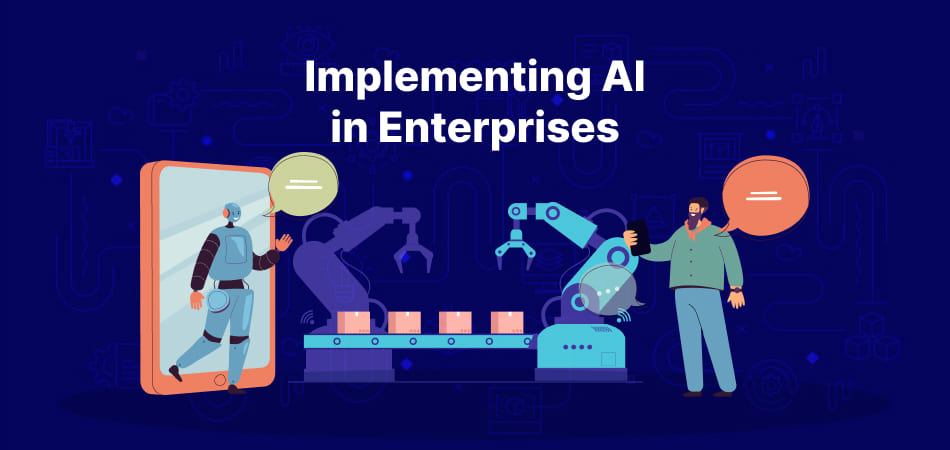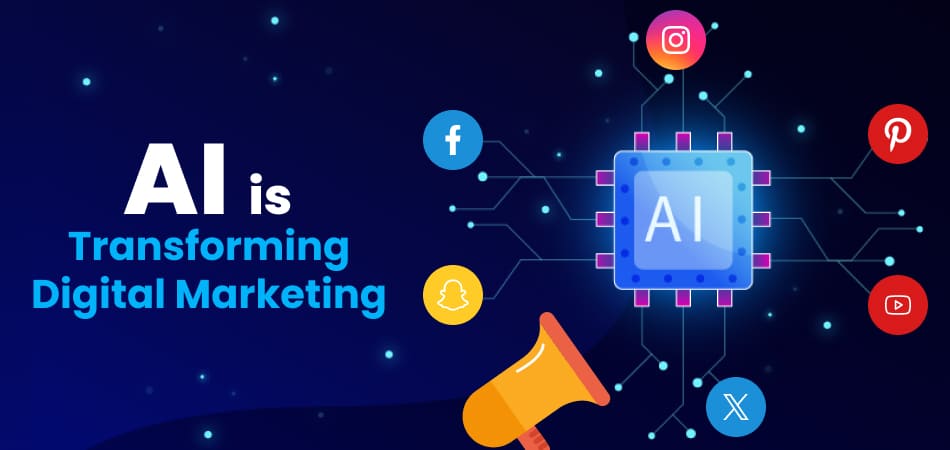Seamlessly efficient operations, data-driven business, employment, and marketing decisions, and highly personalized customer service.
All sound like golden objectives for enterprises. Golden but so very hard to achieve. Well, in 2024, not really.
Artificial Intelligence is making it all happen.
The Numbers are Telling a Story
“About 2-in-5 IT Professionals indicate that their enterprise is implementing generative AI (38%), and another 42%are currently exploring generative AI (42%).”
Source: The IBM Global AI Adoption Index– Enterprise Report, November, 2023
The report also says that:
“AI adoption and exploration, covering both general AI and generative AI, continues to be a substantial focus for enterprises globally one year after the release of GPT-3.”
- “AI has the potential to deliver additional global economic activity of around $13 trillion by 2030, or about 16 percent higher cumulative GDP compared with today.”
“300 AI use cases identified and rated were captured in our AI Impact Index”Source: Exploiting the AI Revolution, A Global Artificial Intelligence Study by PwC
But there are challenges too!!!
Here are a few major challenge statements from the participants of the IBM Global AI Adoption Index – Enterprise Report, November, 2023
- The organization has not yet devised an AI strategy
- The organization is still in the process of developing an AI strategy
- The organization does have an AI strategy. However, it is aimed at limited/specific use cases.
- The organization did devise and adopt an AI strategy but it either had to be discarded or could not be implemented.
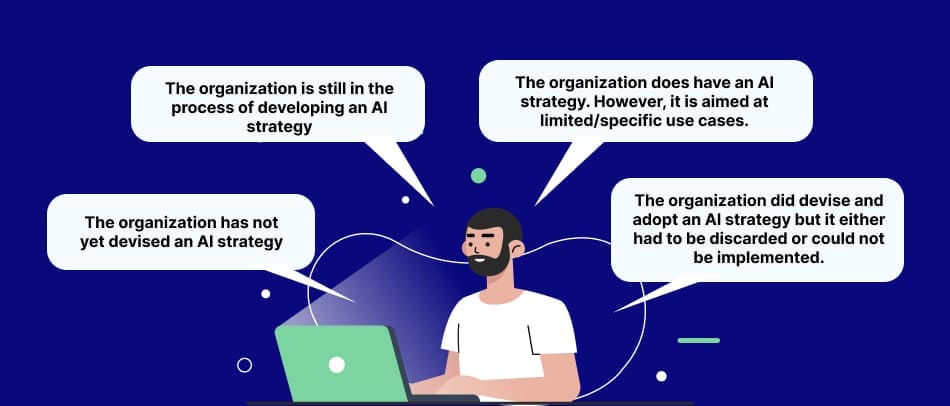
Before we can make absolute sense of what these numbers and statements are trying to tell us, let’s first understand how AI works in enterprises.
Understanding AI in Enterprises
In the enterprise context, AI encompasses a variety of technologies that enable businesses to automate processes, gain insights from data, and improve decision-making capabilities.
AI systems are designed to perform tasks that typically require human intelligence, such as understanding natural language, recognizing patterns, learning from experience, and making decisions.
Types of AI Applications Relevant to Enterprises
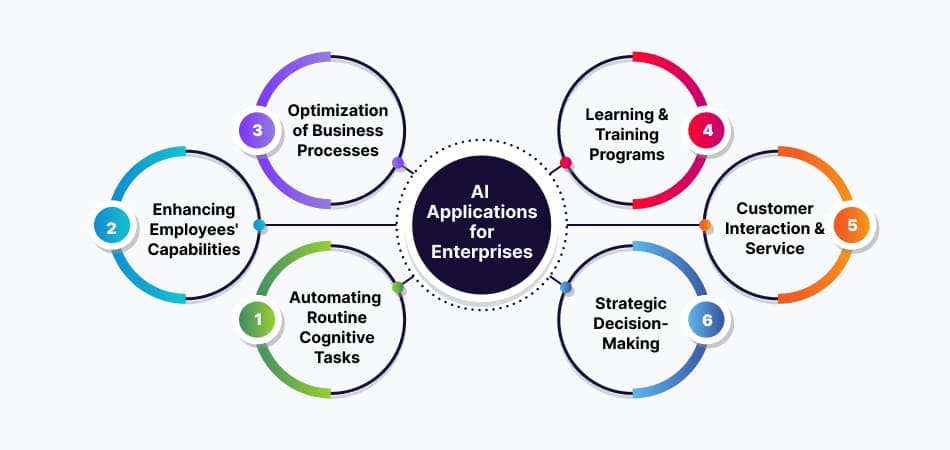
Automating Routine Cognitive Tasks
AI can be used to automate repetitive, data-intensive tasks, freeing human resources for strategic activities and reducing operational costs.
Enhancing Employees’ Capabilities
AI tools have the ability to augment human capabilities in various domains,from writing assistance to generating creative content, coding, and even recruitment. AI contributes to creative fields by generating art, music, and design, enabling new forms of artistic expression and innovation.
Optimization of Business Processes
A decent AI tool can help optimize workflows, supply chains, and other business processes, enhancing efficiency and reducing wastage in terms of hours, resources and cost.
Learning and Training Programs
AI-driven personalized learning experiences improve employee training and development, tailoring content to individual needs and progress.
Customer Interaction and Service
AI in the form of Chatbots virtual assistants can enhance customer service,providing instant support and personalized experiences.
Strategic Decision-Making
AI powered analytics tools have the ability to analyze large datasets to uncover insights and trends, supporting data-driven strategic decisions and long-term planning.
So, coming from the numbers and challenges we quoted above to gaining an understanding of AI in enterprises, we see the following:
The benefits and the projected numbers of AI adoption look peachy, but there may be gaps in implementation that need to be bridged in order to make it work like clockwork.
So, let’s what these gaps or challenges, as we may call them, are.
Challenges in Adoption and How to Resolve Them
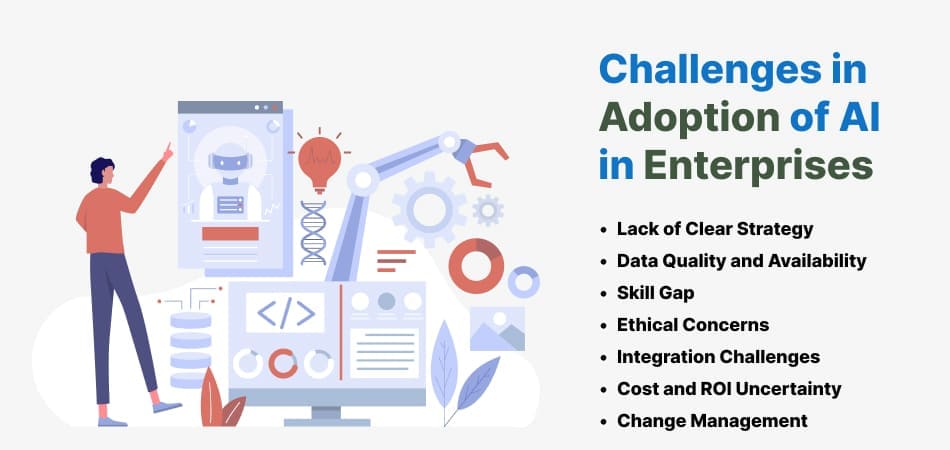
Lack of Clear Strategy
Challenge
In our experience, this is one of the biggest challenges that sabotage successful implementation of AI in enterprises. AI initiatives without a well-defined strategy aligned with business goals often fail to deliver meaningful results. This lack of direction leads to wasted resources, misaligned projects, and unclear outcomes, ultimately hindering the potential benefits AI can bring to the organization.
Solution
Develop a comprehensive AI strategy that aligns with your business objectives. A strategic approach ensures AI initiatives are purposeful, targeted, and capable of driving significant value for the organization.
- Define clear goals, KPIs, and a roadmap for implementation.
- Engage stakeholders across departments to ensure the strategy addresses various business needs.
- Regularly review and adjust the strategy to keep it relevant and aligned with evolving business priorities.
Data Quality & Availability
Challenge
AI is dependent on data. This is a tenet that we always emphasize on. Poor data quality and availability almost always to inaccurate models and unreliable outcomes. Inconsistent or incomplete data can even skew AI predictions and insights, making them less trustworthy and effective for decision-making.
Solution
Make sure that your data is legit and relevant to the outcomes you want to achieve.
To ensure reliable, high-quality data that enhances AI model accuracy and reliability:
- Invest in robust data management practices to ensure data is clean, accurate, and accessible.
- Implement data governance frameworks to maintain data quality, standardize data collection processes, and regularly audit data sets.
Skill Gap
Challenge
Since AI is a relatively recent technology, we’ve almost always encountered the problem of skill gap. It is very likely that your existing staff lack the knowledge and skill to implement and succeed in obtaining outcomes through AI. One, it is not their fault. Two, it can be corrected easily.
Solution
The solution lies in having a team that knows how to implement and then how to manage AI for the organization.
- One way to resolve this is by hiring skilled professionals who already know how AI is used in those particular use cases which your organization has earmarked.
- You could, alternatively, partner with AI consultants or firms if in-house hiring isn’t possible, majorly because of cost and talent crunch. .
- The other way is by upskilling the existing staff through training programs. This also becomes necessary after a point because all the departments using AI will need to be able to work with the new tech changes.
Ethical Concerns
Challenge
AI being highly dependent on data and information becomes susceptible to quite a few ethical concerns. And since it is a rather evolving technology, the regulations around the discipline are also relatively new and not as standard as one may like them to be. This is why organizations may unknowingly end up ignoring ethical considerations. This can lead to biased AI decisions, reputational damage, and legal issues. Unfair or opaque AI systems can erode trust and negatively impact users and stakeholders.
Solution
To address ethical concerns with AI, key approaches may include:
- Enhancing privacy protections
- Promoting algorithmic fairness
- Improving security and reliability
- Safeguarding human dignity and autonomy
- Establishing comprehensive ethical governance frameworks: This is the most important of all since it oversees all the other concerns. It involves implementing robust data policies, mitigating biases, ensuring cybersecurity, maintaining human oversight, and collaborating with stakeholders to develop guidelines regulating the responsible development and deployment of AI systems.
Establish ethical guidelines for AI development and use.Conduct regular audits to ensure AI models are fair and unbiased. Involve diverse teams in AI projects.
Integration Challenges
Challenge
Poor integration of AI systems with existing IT infrastructure can lead to operational inefficiencies and increased costs. And this can happen in two ways. One, the existing infrastructural setup not being ready or compatible for integrating AI; two, the integration process itself not being proper.
Solution
Status quo analysis and planning is not only important but also necessary. This ensures AI systems work harmoniously within the existing IT ecosystem, maximizing efficiency and minimizing disruption.
- Assess compatibility beforehand
- Use APIs and middleware for seamless connectivity
- Conduct thorough testing to identify and resolve integration issues early.
Cost and ROI Uncertainty
Challenge
Initial investments in AI can be substantial, and achieving a positive return on investment (ROI) may take time. Organizations may often commit the folly of investing in AI without having a compelling business case for it. Also, post investment and implementation, lack of careful monitoring and management may cause organizations to struggle with justifying continued AI funding or even the initial investment for that matter.
Solution
Your business case as well as management post investment must be solid. Due diligence is called due diligence for a reason.
- One important step is to weigh the business case for AI thoroughly before investing in it.
- Start with small, scalable AI projects that can demonstrate quick wins and measurable ROI.
- Continuously monitor and evaluate the financial impact of AI initiatives.
- Continuously monitor performance metrics to track ROI and adjust strategies as needed.
This approach helps demonstrate AI’s financial benefits and ensures sustainable investment in future initiatives.
Change Management
Challenge
Resistance to change among employees and stakeholders can hinder AI adoption. Without proper engagement and support, employees may perceive AI as an unnecessary complication or even a threat to job security.
Solution
Engage stakeholders early in the process. Provide training and support.Communicate the benefits and impact of AI clearly.
- Engage stakeholders early,communicate the benefits of AI clearly.
- Provide comprehensive training and support to help employees embrace AI.
- Foster a culture that welcomes innovation and continuous learning.
- Address concerns proactively to facilitate smooth AI adoption and maximize its potential benefits across the organization.
Future Outlook and Trends
When it comes to the use of AI in enterprises, it is somewhat different from what an individual would expect AI to do for them. The expectations will be higher because well, the investment is projected to go much higher in the present decade. Per our insight, this is causing several emerging trends to shape the AI landscape.
We’ve started seeing the innovation already and we also expect to see more possibilities such as:
- Integration of AI with Internet of Things (IoT) devices
- enabling real-time data analysis and predictive maintenance
- Natural Language Processing (NLP)and computer vision are also advancing, enabling AI systems to understand and interact with human language and visual data more effectively.
- AI-driven cybersecurity solutions are becoming crucial to safeguarding digital assets against evolving threats.
How the World May Leverage AI in Times to Come
Looking ahead, AI adoption is poised to accelerate across industries. Innovations in autonomous systems will revolutionize transportation and manufacturing sectors. AI’s role in healthcare is expected to grow, with personalized medicine and predictive analytics improving patient outcomes. Ethical AI frameworks will become standard practice, addressing concerns around bias and privacy. Overall, AI’s transformative impact on enterprises will continue to expand, driving efficiency, innovation, and competitive advantage in a rapidly evolving digital economy.
Conclusion
No technological innovation comes without its challenges. So long as the opportunities outweigh and outnumber cons, great outcomes can be achieved. So is the case with AI, mostly for being in its evolving stages as a mainstream technology. However, these challenges can be resolved mostly with good planning,which leads to good execution. By navigating these challenges thoughtfully, organizations can harness the full potential of AI to drive innovation, efficiency, and competitive advantage in their operations.
If you are ready or are getting ready for implementing AI in your enterprise, our experts can help you navigate smoothly in achieving the outcomes you have in mind.
